The IoT Testing Equipment Market is estimated to be valued at USD 5.1 billion in 2025 and is projected to reach USD 77.2 billion by 2035, registering a compound annual growth rate (CAGR) of 31.3% over the forecast period.
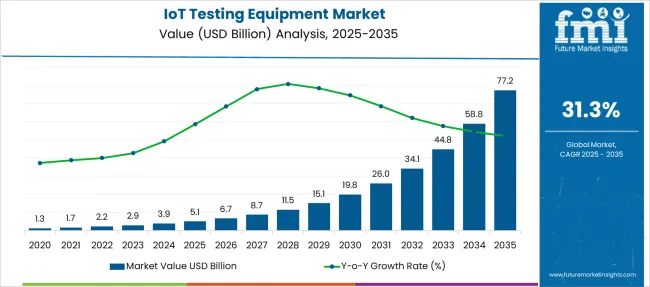
| Metric | Value |
|---|---|
| IoT Testing Equipment Market Estimated Value in (2025 E) | USD 5.1 billion |
| IoT Testing Equipment Market Forecast Value in (2035 F) | USD 77.2 billion |
| Forecast CAGR (2025 to 2035) | 31.3% |
The IoT testing equipment market is experiencing rapid growth as the adoption of connected devices expands across residential, commercial, and industrial sectors. The increasing complexity of IoT networks and the need to ensure device interoperability, security, and performance have driven demand for advanced testing solutions.
Industry discussions have highlighted the importance of protocol compliance testing to guarantee seamless communication between heterogeneous devices. Rising consumer interest in smart homes and residential automation has also fueled the need for rigorous testing of IoT products intended for residential use.
Technological advances in test equipment design have enhanced automation and accuracy, reducing time-to-market for IoT devices. Future growth is expected to be propelled by expanding IoT deployments, emerging communication standards, and the emphasis on cybersecurity. Segmental growth is anticipated to be driven by Protocol Testing Equipment as the leading product type and Residential Use as the key application segment.
The market is segmented by Type and Application and region. By Type, the market is divided into Protocol Testing Equipment, Spectrum Testing Equipment, Network Testing Equipment, and Other Types. In terms of Application, the market is classified into Residential Use, Commercial Use, and Industrial Use. Regionally, the market is classified into North America, Latin America, Western Europe, Eastern Europe, Balkan & Baltic Countries, Russia & Belarus, Central Asia, East Asia, South Asia & Pacific, and the Middle East & Africa.
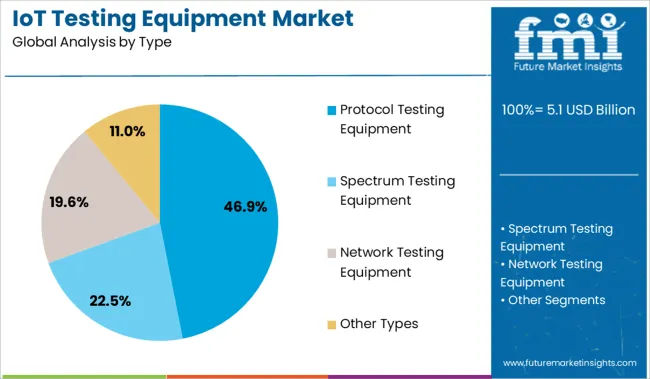
The Protocol Testing Equipment segment is projected to hold 46.9% of the IoT testing equipment market revenue in 2025, retaining its leadership in product type. This segment’s growth has been propelled by the critical need to verify the compatibility of IoT devices with various communication protocols such as Wi-Fi, Bluetooth, Zigbee, and others.
Accurate protocol testing ensures devices can reliably connect and interact within complex IoT ecosystems. Manufacturers and service providers have prioritized protocol compliance to avoid connectivity issues and security vulnerabilities.
The increasing diversity of IoT standards and the proliferation of multi-protocol devices have further expanded the demand for comprehensive protocol testing solutions. As IoT networks become more sophisticated, protocol testing equipment will remain indispensable to ensure device interoperability and system stability.
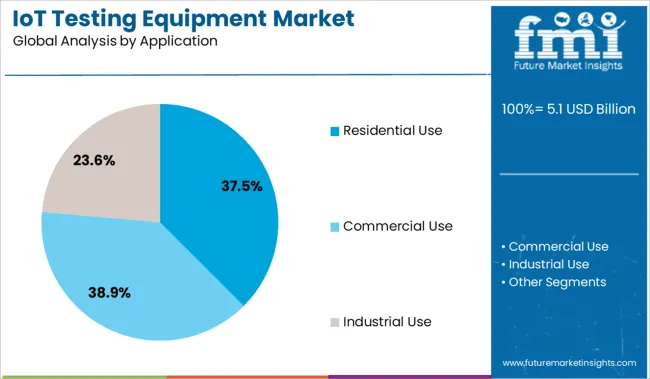
The Residential Use segment is expected to account for 37.5% of the IoT testing equipment market revenue in 2025, establishing it as the leading application area. Growth in this segment has been fueled by the booming smart home market where connected devices such as smart thermostats, security cameras, and lighting systems require thorough testing to ensure user satisfaction and safety.
The increasing adoption of residential IoT solutions has driven manufacturers to implement rigorous testing protocols to comply with industry standards and consumer expectations. Residential environments present unique challenges such as varying network conditions and user behaviors which testing equipment must accommodate.
As smart home technology continues to advance and gain mainstream acceptance, the Residential Use segment is poised to maintain its dominant position in the market.
The increasing adoption of IoT devices in the residential, industrial, and commercial sectors is driving the global IoT testing equipment market. The government initiatives such as smart cities, connected buildings, and smart homes are fuelling the global IoT testing equipment market.
The continuous development in infrastructure, increasing adoption of smartphones, and others are also expected to have a positive impact on the growth of the global IoT testing equipment market.
The challenges associated with the growth of the global IoT testing equipment market are the failure in real-time data testing, hardware-software compatibility, and others. However, vendors are continuously focused on the development of advanced IoT testing equipment to overcome the above-mentioned challenges.
The Asia-Pacific IoT testing equipment market is likely to observe substantial growth with a CAGR of approximately 13% during the forecast period. The APAC region is estimated to be one of the principal markets for the growth of the IoT market. Owing to the factors such as increasing internet penetration, rising adoption of cloud-based services among small and medium enterprises, and government strategies to encourage digitalization and smart city developments.
Moreover, the induction of high-speed networking technologies has been the key factor driving the market. With the increasing concentration of multinational players in the region and soaring investments, the market for IoT testing equipment is likely to propagate in the forthcoming period.
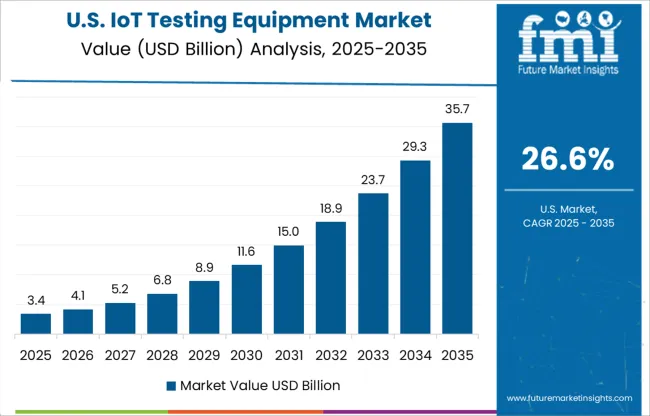
North America captured nearly 35% share in 2024 and is likely to maintain its dominance throughout the forecast period. The mounting adoption of IoT devices in the residential, industrial, and commercial sectors is propelling the global IoT testing equipment industry. The government initiatives such as smart cities, connected buildings, and smart homes are stimulating the IoT testing equipment market in North America.
Several North American governments are instigating new track review criteria to improve the operational efficiency of railway activities. For instance, in August 2024, the USA Department of Transportation's (DoT's) Federal Railroad Administration (FRA) offered to the Federal Register a final rule asserting the usage of ultrasonic inspection technology enabling railroads to execute continuous rail testing activities, which restructured with GPS technology.
The incessant development in infrastructure and swelling adoption of smartphones has placed the IoT Testing Equipment market on a positive growth trajectory in the region.
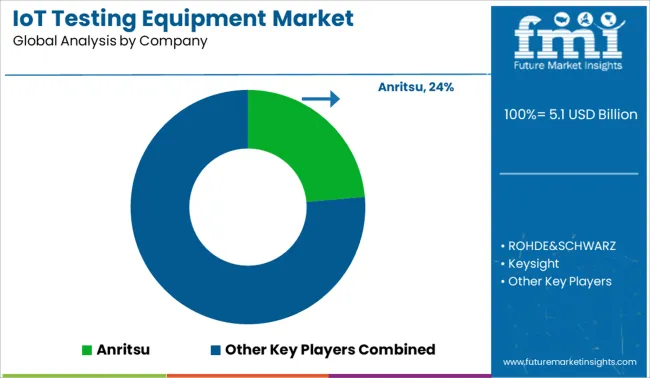
Some of the key participants present in the global demand of the IoT Testing Equipment market include McGrath RentCorp, Inc., Anritsu, ROHDE&SCHWARZ, Keysight Technologies, Ixia, RIGOL Technologies, Inc., Tekronix, Infostretch Corporation, Shenzhen Te-lead Technologies Co., Ltd, Test IO, and others and other IoT Testing Equipment manufacturers., among others
| Report Attribute | Details |
|---|---|
| Growth Rate | CAGR of 31.3% from 2025 to 2035 |
| Market Value (2025) | USD 5.1 billion |
| Market Value (2035) | USD 77.2 billion |
| Base Year for Estimation | 2024 |
| Historical Data | 2020 to 2024 |
| Forecast Period | 2025 to 2035 |
| Quantitative Units | Revenue in USD Billion, Volume in Kilotons, and CAGR from 2025 to 2035 |
| Report Coverage | Revenue Forecast, Volume Forecast, Company Ranking, Competitive Landscape, Growth Factors, Trends, and Pricing Analysis |
| Segments Covered | Product Type, Application, Region |
| Regions Covered | North America; Latin America; Western Europe; Eastern Europe; SEA and Other APAC; China; Japan; Middle East and Africa |
| Key Countries Profiled | USA, Canada, Brazil, Mexico, Germany, UK, France, Spain, Italy, Nordics, BENELUX, Russia, Poland, Australia & New Zealand, India, ASEAN, GCC, South Africa |
| Key Companies Profiled | McGrath RentCorp, Inc.; Anritsu; ROHDE&SCHWARZ; Keysight Technologies; Ixia; RIGOL Technologies, Inc.; Tekronix; Infostretch Corporation; Shenzhen Te-lead Technologies Co., Ltd; Test IO; and others. |
| Customization | Available Upon Request |
The global iot testing equipment market is estimated to be valued at USD 5.1 billion in 2025.
The market size for the iot testing equipment market is projected to reach USD 77.2 billion by 2035.
The iot testing equipment market is expected to grow at a 31.3% CAGR between 2025 and 2035.
The key product types in iot testing equipment market are protocol testing equipment, spectrum testing equipment, network testing equipment and other types.
In terms of application, residential use segment to command 37.5% share in the iot testing equipment market in 2025.






Our Research Products

The "Full Research Suite" delivers actionable market intel, deep dives on markets or technologies, so clients act faster, cut risk, and unlock growth.

The Leaderboard benchmarks and ranks top vendors, classifying them as Established Leaders, Leading Challengers, or Disruptors & Challengers.

Locates where complements amplify value and substitutes erode it, forecasting net impact by horizon

We deliver granular, decision-grade intel: market sizing, 5-year forecasts, pricing, adoption, usage, revenue, and operational KPIs—plus competitor tracking, regulation, and value chains—across 60 countries broadly.

Spot the shifts before they hit your P&L. We track inflection points, adoption curves, pricing moves, and ecosystem plays to show where demand is heading, why it is changing, and what to do next across high-growth markets and disruptive tech

Real-time reads of user behavior. We track shifting priorities, perceptions of today’s and next-gen services, and provider experience, then pace how fast tech moves from trial to adoption, blending buyer, consumer, and channel inputs with social signals (#WhySwitch, #UX).

Partner with our analyst team to build a custom report designed around your business priorities. From analysing market trends to assessing competitors or crafting bespoke datasets, we tailor insights to your needs.
Supplier Intelligence
Discovery & Profiling
Capacity & Footprint
Performance & Risk
Compliance & Governance
Commercial Readiness
Who Supplies Whom
Scorecards & Shortlists
Playbooks & Docs
Category Intelligence
Definition & Scope
Demand & Use Cases
Cost Drivers
Market Structure
Supply Chain Map
Trade & Policy
Operating Norms
Deliverables
Buyer Intelligence
Account Basics
Spend & Scope
Procurement Model
Vendor Requirements
Terms & Policies
Entry Strategy
Pain Points & Triggers
Outputs
Pricing Analysis
Benchmarks
Trends
Should-Cost
Indexation
Landed Cost
Commercial Terms
Deliverables
Brand Analysis
Positioning & Value Prop
Share & Presence
Customer Evidence
Go-to-Market
Digital & Reputation
Compliance & Trust
KPIs & Gaps
Outputs
Full Research Suite comprises of:
Market outlook & trends analysis
Interviews & case studies
Strategic recommendations
Vendor profiles & capabilities analysis
5-year forecasts
8 regions and 60+ country-level data splits
Market segment data splits
12 months of continuous data updates
DELIVERED AS:
PDF EXCEL ONLINE
Riot Control Equipment Market Size and Share Forecast Outlook 2025 to 2035
5G Testing Equipment Market Analysis - Size, Growth, and Forecast 2025 to 2035
Eye Testing Equipment Market Size and Share Forecast Outlook 2025 to 2035
LTE Testing Equipment Market Growth – Trends & Forecast 2019-2027
Sand Testing Equipments Market Size and Share Forecast Outlook 2025 to 2035
Physiotherapy Equipment Market Analysis – Trends, Forecast & Insights 2025 to 2035
Drug Testing Equipment Market
Steel Testing Equipment Market Size and Share Forecast Outlook 2025 to 2035
Metal Testing Equipment Market Size and Share Forecast Outlook 2025 to 2035
Glass Testing Equipment Market Size and Share Forecast Outlook 2025 to 2035
Shear Testing Equipment Market Size and Share Forecast Outlook 2025 to 2035
Blood Testing Equipment Market Growth - Trends & Forecast 2025 to 2035
Motor Testing Equipment Market - Growth & Demand 2025 to 2035
Mortar Testing Equipment Market Size and Share Forecast Outlook 2025 to 2035
Fabric Testing Equipment Market Size and Share Forecast Outlook 2025 to 2035
Rubber Testing Equipment Market Growth – Trends & Forecast 2025 to 2035
Asphalt Testing Equipment Market Size and Share Forecast Outlook 2025 to 2035
Telecom Testing Equipment Market Size and Share Forecast Outlook 2025 to 2035
Bitumen Testing Equipment Market Size and Share Forecast Outlook 2025 to 2035
Battery Testing Equipment Market Growth – Trends & Forecast 2025 to 2035

Thank you!
You will receive an email from our Business Development Manager. Please be sure to check your SPAM/JUNK folder too.
Chat With
MaRIA